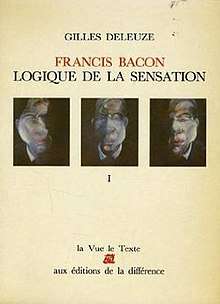Francis Bacon: The Logic of Sensation
Francis Bacon: The Logic of Sensation (French: Francis Bacon-Logique de la sensation) is a 1981 book by the philosopher Gilles Deleuze, in which the author creates novel concepts related to art, aesthetics, percepts and sensation through the example of the work of the celebrated English painter Francis Bacon. It was translated into English by Daniel W. Smith.
 Cover of the first edition | |
| Author | Gilles Deleuze |
|---|---|
| Original title | Francis Bacon-Logique de la sensation |
| Translator | Daniel W. Smith |
| Country | France |
| Language | French |
| Subject | Francis Bacon |
| Published |
|
| Media type | |
| Pages | 209 pages (Continuum edition, 2003) |
| ISBN | 978-0816643424 |
The book presents a deep engagement with Bacon's work and the nature and potential of art. But while occasionally viewed solely as a work of art history, Deleuze's larger motivation is the conception of art beyond "representation".
Deleuze's art theory
The zone of indiscernibility (a parallel to the plane of immanence which also artistically follows lines of flight in "the act of fleeing or eluding"[1]) is discussed in this book as a distinct zone that Bacon's art – its bodies as figures, and spaces as "round areas" – exists in. However, the book is intended to be built on a slow intensification of its titular viewpoint, "a general logic of sensation": "in an order that moves from the simplest to the most complex."[2]:ix Deleuze's concept of becoming, which he had explored in detail a year earlier with Félix Guattari in A Thousand Plateaus (1980), is a theoretical base for his interpretation of Francis Bacon's art.
In a mode similar to another previous work of his, The Logic of Sense (1969), Bacon's use of smearing, detachment and destruction of signifiers in relation to bodies, modern myths and portraits is transgressive enough to evoke a full logic of sensation from Deleuze. Deleuze remarks in the final preface of the book that Francis Bacon's art is "of a very special violence."[2]:x In saying this, he analyzes the familiar content of Bacon's paintings, which make "use of spectacles of horror, crucifixions, prostheses and mutilations, monsters," but are always set on fields of color with shallow depth. One of his main literary examples, staying in a mode of rhizomatic analysis that his works are often characterized by, is a line from Samuel Beckett's short story "The Lost Ones" (1966-1970): "Inside a flattened cylinder. [...] The light, [...] Its yellowness." However, Deleuze remarks that "if these fields of color press toward the Figure, the Figure in turn presses outward, trying to pass and dissolve through the fields."[2]:xi
References
- Brian Massumi, "Notes on the Translation and Acknowledgments" to Deleuze and Guattari (1980, xvi)
- Deleuze, Gilles. Francis Bacon: The Logic of Sensation. Continuum Press.
Further reading
Deleuze, Gilles (2003) Francis Bacon: The Logic of Sensation. London: Continuum